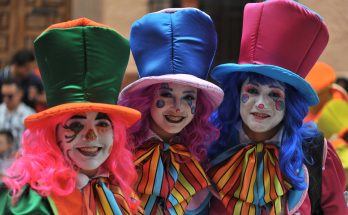By Francisco Peyret
“Through complex community rituals, some centuries-old indigenous communities keep alive and robust their identity and sense of belonging on this cultural frontier between volcanic Mesoamerica and semi-desert Aridoamerica, mainly around the upper sub-basin of the Laja River and its tributaries. Historical communities with deeper and more syncretic traditions due to their Mesoamerican pre-Hispanic cultural roots were transformed by force and cultural pressure from the powerful Spanish armed forces and faith, part of their forms, uses, and customs, from their buildings to their rituals, with enough Christian appearance to be accepted by the dominant hierarchy, to this day.»— Arturo Morales
The historic founding neighborhoods of San Miguel de Allende continue to contribute authenticity, diversity, and cultural richness to the city. One of those neighborhoods is Valle del Maíz, one of the oldest, where a majority of its inhabitants are of Chichimeca and Otomí origin. Annually, during the second half of May, the inhabitants of this neighborhood celebrate the Fiesta de la Santa Cruz. This includes a mixture of Catholic and pre-Hispanic traditions, where a Catholic symbol such as the cross is venerated while indigenous dances and rituals such as the blessing of the four winds, part of Chichimeca culture before the Spanish conquest, are performed.
The yearly Fiesta de la Santa Cruz in Valle del Maíz is one of the community’s favorite celebrations. With time, it has gained social recognition and followers.
To better understand this event, we went to meet the protagonists of this festivity up close. I got an interview with Don Gerardo Estrada, a member of one of the most involved families, participating in the organization and preservation of the neighborhood traditions. Don Gerardo says that eight days after each celebration, the organizing team, the Mayordomía, reports on how each event of the recent festivity developed. In that meeting, they evaluate and decide if the team stays or new mayors are appointed.
According to Don Gerardo, the main festival objective, to give thanks for the blessings received during the previous year and to ask for a good rainy season and abundant harvest, is centered around the agricultural cycle and dedicated to the four winds so that rain comes and food does not run out. The focus is on asking for good weather and the community’s health. The Holy Cross spends time on tour during the year, also visiting rancherias and communities to help them with good wishes. In the past, these communities brought offerings and food for the celebration’s participants, even generating resources to finish building the chapel.
The event starts with a vigil at the Holy Cross, followed by a request for permission to hold the fiesta before the Holy Cross departs from the temple. Gunpowder, flowers, and offerings are collected to return to Valle later. When the contingent arrives at the church, everyone gathers to honor the sun, mother earth, water, air, ancestors, holy souls, and God.
Don Gerardo comments that each activity, such as taking the decorations to the church, watching over the gunpowder and the xuchiles, and making offerings for the vigil, is performed in strict sequence. Don Gerardo’s generation learned these activities from childhood, and he nostalgically remembers how the «Desfile de las Yuntas» (Parade of the Yokes) used to be. Families would adorn their oxen and their cows, but that has ended. The festival is changing, and now young people replace animals with cardboard structures. Don Gerardo points out that the territory of Valle has changed, too. It was a semi-rural area that today is filled with houses. He tells us that with the changes in Valle del Maíz festival, there is a danger of losing respect for tradition.
As the city’s chronicler Luis Felipe Rodríguez points out, «All the works and activities that are carried out are done with the consent and collaboration of all the neighbors. They have always demonstrated great unity, particularly in the defense of their customs and traditions. Although several of the current neighbors do not belong to the original families, and even several of them are foreigners, they have had to adapt, as they should, to the customs of this iconic place where traditions have deep roots.» Among the festival activities are the xuchil festival vigil, the combating Indians against soldiers, the traditional yokes, the main vigil of the Holy Cross, dawn serenades, musical presentations, folk dances, the dance of mojigangas, pedestrian races, the «crazy painting,» parades, the much-awaited presentation of the Leones de la Sierra de Xichú, and the end of the festival is the colloquium, «The Hidden Treasure,» and the fireworks.
For Don Gerardo, the festival is changing. Now about 10 families of foreigners have integrated into the community and participate in the celebrations. They come voluntarily and help a lot, and the festival is growing. Municipal governments have tried to integrate it as a tourist attraction, but traditionalists are trying to preserve the purity of the festival that they have protected for so long, and they will not allow it. This is something for the community. «There is always someone who wants to take advantage of the commerciality of an event,» he concludes. «It is difficult to quantify everything that is done in the festival. It has an intimate side, love, fervor, [and] passion for venerating an image. It is something serious and difficult to explain.»
Don Gerardo talks about the history of the Chichimecas, a very difficult race to conquer. They were fearsome, but according to Don Gerardo’s understanding, the Spaniards were able to turn the different sections of Chichimecas against each other. He tells of a legend of a cross that appeared on the same day in 1561, at the same time, in different places such as Puerto de Calderón, Tlaxcala, and Querétaro. He said this appearance was planted so they would accept the new religion. But the Indians never accepted worshipping an image created by the Spaniards, so they created a cross using the elements they venerated, such as stones, plants, flowers, and materials used in their ancestral traditions.
«Hopefully, this year, you can experience the festival more closely so that you can better understand this tradition. Don’t hesitate to ask questions. It is essential to keep asking,» Don Gerardo tells us.
Gerardo Estrada is a retired medical equipment technician who worked for 34 years as a professional in León, Celaya, Guanajuato, and San Miguel at the Mexican Social Security Institute. He is also a faithful guardian of the traditions of his neighborhood, like all members of his family. Don Gerardo is also the brother of the late, illustrious Polo Estrada, who was well known for his work as a traditionalist and for his mojigangas.
We thank Gerardo Estrada, Jr. for introducing us to his father, and we wish him all the luck as the mayordomo responsible for the organization of the Festivities in Honor of the Holy Cross of Valle del Maíz 2023.




